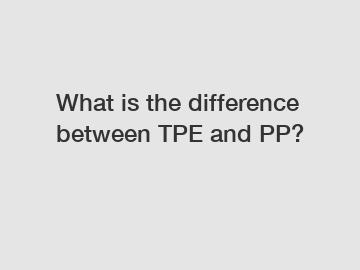What is the difference between TPE and PP?
What is the difference between TPE and PP?
Thermoplastic elastomers (TPE) and polypropylene (PP) are two commonly used materials in various industries. However, their properties, applications, and performance differ significantly. Understanding the differences between TPE and PP is crucial for making informed decisions when choosing the right material for a specific application. In this article, we will explore the disparities between TPE and PP, highlighting their key attributes and applications.

TPE: Flexible and Versatile Material.
TPE is a type of synthetic polymer that combines the characteristics of thermoplastics and elastomers. It exhibits elasticity similar to rubber while retaining the moldability and processability of thermoplastics. TPE can be softened and reshaped repeatedly under heat, making it suitable for various manufacturing techniques such as injection molding and extrusion. Some common types of TPE include TPE-S, TPE-O, TPE-U, and TPE-E.
Elasticity and Flexibility:
One of the key differences between TPE and PP is their elasticity and flexibility. TPE offers superior elasticity, allowing it to stretch and recover its original shape easily. On the other hand, PP is a stiffer material with limited elasticity. Therefore, TPE is often preferred for applications requiring flexibility and resilience, such as seals, gaskets, and soft touch components.
Chemical Resistance:
When it comes to chemical resistance, PP outperforms TPE in most cases. PP has excellent resistance to acids, alkalis, and many organic solvents. It can withstand exposure to a wide range of chemicals without significant degradation. In contrast, TPE's chemical resistance varies depending on its specific formulation. Some types of TPE are more resistant to chemicals than others. Therefore, the chemical compatibility should be considered carefully while selecting a material for applications involving exposure to substances like oils, solvents, and acids.
Temperature Resistance:
PP offers better performance in high-temperature environments compared to most TPEs. It can withstand temperatures up to 100°C without significant deformations or loss of mechanical properties. TPE, on the other hand, generally has a lower temperature resistance and may start to soften or deform at temperatures around 60-80°C. However, certain specialty TPE formulations can exhibit improved temperature resistance, expanding their applications in higher temperature environments.
Applications of TPE and PP:
Owing to its flexibility, TPE finds applications in various industries, including automotive, consumer goods, electronics, and medical devices. It is widely used for soft-touch grips, seals, gaskets, bumpers, and handles. Moreover, TPE's ease of processing and recyclability make it an environmentally friendly choice.
PP, on the other hand, is a versatile material widely used in packaging, automotive components, textiles, and industrial applications. Its high chemical resistance, rigidity, and excellent fatigue resistance make it suitable for applications such as plastic bottles, automotive parts, pipes, and fibers.
Conclusion:
In conclusion, TPE and PP are two distinct materials with different properties and applications. TPE offers excellent flexibility, elasticity, and ease of processing, making it suitable for applications requiring soft-touch components. PP, on the other hand, is characterized by its high chemical resistance, rigidity, and temperature stability, making it ideal for a wide range of applications.
When choosing between TPE and PP, it is essential to consider the specific requirements of the application such as flexibility, chemical resistance, and temperature resistance. Consulting with an expert or material supplier can provide valuable insights to ensure the appropriate material selection. For further information or assistance, please feel free to contact us.
Are you interested in learning more about yamamoto neoprene wetsuit factory? Contact us today to secure an expert consultation!



